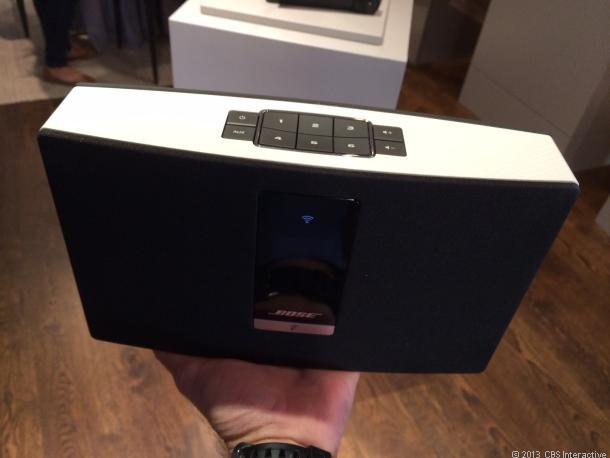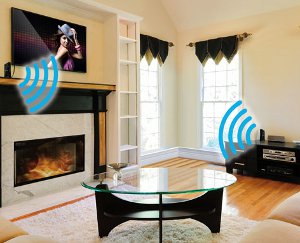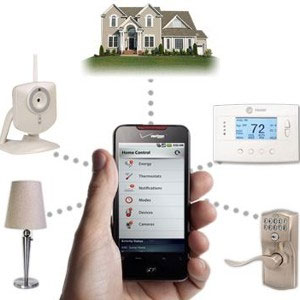
Bose SoundTouch throws down multiroom audio gauntlet to Sonos
New SoundTouch Wi-Fi line includes three speaker models at launch: the SoundTouch 30, SoundTouch 20, and SoundTouch Portable
 All the speakers have six 'presets' on top of the unit. This speaker is the SoundTouch Portable, which has a built-in rechargeable battery Over the years, Sonos, once a fledgling startup, has grown up to dominate the DIY multiroom wireless audio space. Now it has some serious competition.
Bose has officially unveiled a new line of Wi-Fi speakers under its new SoundTouch brand, which features simple setup and operation, and it’s definitely aimed at the same audience that Sonos has targeted.
The three new speakers that are available at launch — you can order them today — are the SoundTouch 30 ($699), a larger speaker designed for larger living spaces, and the SoundTouch 20 ($399) and SoundTouch Portable ($399), which are designed for somewhat smaller rooms. Bose will also introduce a Wave SoundTouch music system ($599) in December and other SoundTouch speakers and audio products in early 2014, signaling that it’s going all in on wireless audio.
It shares many of the same traits as the Sonos system, but one of the differences is that it’s designed to work with your existing Wi-Fi network and doesn’t require a special “bridge” like Sonos does. However, that Sonos Bridge, which connects to the Ethernet port on your router, sets up a separate “mesh” wireless network that’s dedicated to streaming your audio and helps remove the hiccups typically associated with a Wi-Fi network, which aren’t incredibly reliable.
But Bose is pushing the simplicity of its system and how easy it is to set up “using your existing home Wi-Fi network” and nothing else. The other simplicity theme revolves around Bose’s use of “presets”; both the new speakers and new apps — Android and iOS devices are supported at launch along with Macs and Windows PCs — are equipped with buttons numbered 1-6. Each number corresponds to a preset in the app.
Using the apps, you can drag and drop specific Pandora radio stations onto a number to set it as a preset. You can also link one of the presets to the music library on your PC or a specific playlist.
To get your music up and running, you simply press one of the preset buttons that’s on the speaker or the included remote, or within one of the apps. Thus, the SoundTouch name.
Sonos comparisons
Like Sonos, the speakers and apps will get software updates that add new features and services. At launch, I was underwhelmed with Bose’s line up of services. Beyond Pandora there’s nothing: no Spotifiy, no Rdio, no Deezer, no nothing. Sonos has a huge roster of service tie-ins, so Bose has a big hole to fill there.
The other thing you can’t do with the Bose SoundTouch speakers is combine two speakers to get stereo sound. That starts to get a little expensive when you’re combining $399 speakers to make a pair, but these types of speakers that have their drivers very close together typically feature little to no stereo separation, so it’s a nice option to be able to go stereo like you can with Sonos.
The SoundTouch 30 and SoundTouch 20 both offer Ethernet connectivity, so you can use a wired network connection if you want, and there’s an auxiliary input, so you can hook up an audio device to a speaker using a cable.
The Bose speakers aren’t equipped with Bluetooth (neither are the Sonos speakers), but they do support AirPlay streaming from iOS devices and PCs running iTunes. And like Sonos, you can stream music to a single room or have the same music play on all your speakers at the same time. You should be able to play different music sources in different rooms, but I didn’t test that feature yet.
Sound demo
Bose did a sound demo in a controlled environment with hand-picked music tracks, and like most of Bose’s demos, the speakers came across in their best light and seemed to sound quite decent for their size. I suspect the SoundTouch 20 will match up just fine against the Sonos Play:5, which is about the same size and also retails for $399. Currently, Bose isn’t offering any SoundTouch speakers for less than $399, but you’d think that may change in the future with Sonos offering more-affordable speakers.
However, the next batch of SoundTouch products will be more expensive except for the SoundTouch Controller, a swankier remote that will come out early in 2014 for $99.
As I said, a Wave SoundTouch music system is coming in December for $599. And a SoundTouch Stereo JC (Jewel Cube) system ($1,199), a SoundTouch SA-4 amplifier ($499) for select Bose products (including outdoor speakers), and a SoundTouch wireless adapter for Lifestyle systems and VideoWave entertainment system will ship in “early 2014.” (Bose did demo that new stereo Jewel Cube system, which also includes a subwoofer, and, needless to say, it sounded better than the single-speaker systems.)
I’ll let you know how the launch speaker systems sound — and how smoothly they operate — as soon as we get our hands on some review samples. Naturally, it will be interesting to see how the market responds to having a second major competitor in the DYI multiroom wireless audio space. But one thing is clear from Bose’s announcement: it’s going all in on wireless audio; it’s not messing around and will surely put big bucks toward marketing the new SoundTouch line and telling everybody how easy it is to use.
by David Carnoy
http://reviews.cnet.com/8301-33199_7-57606930-221/bose-soundtouch-throws-down-multiroom-audio-gauntlet-to-sonos/
Custom Installation Services, LLC – Authorized Bose Dealer in Charlotte, NC and surrounding areas
Posted in Audio Demos, Audio Systems, Home Theater, Home Theater Setup, Multi Room A/V, Music and Movies, News, Outdoor Speakers, technology
|
Tagged 3d theater in charlotte, bose dealer, Bose SoundTouch, Bose Theater, charlotte custom home builders, Charlotte Home Theater, geek squad in charlotte nc, high end audio, home automation companies in charlotte, home remodelers, Home theater installers Lake Norman, home theater setup, multiroom audio, Universal Remote programmers in charlotte nc, whole house audio, wireless audio, wireless networks
|
Wireless: Is It Really as Good as It Sounds?
Integrators need to educate customers better that ‘wireless’ audio does not mean ‘no new wires,’ and installing a cable-less system is not necessarily less labor intensive.
 Wireless has its place when used properly, but it doesn’t mean no new wires. It is obvious many custom manufacturers of multiroom audio systems are pinning their hopes for 2014 on new wireless audio products. Wireless is a wonderful solution; it eliminates the need to pre-wire a house and can be installed as a retrofit. Now that video can be transmitted around the home via wireless, audio transmission should be a breeze.
However, not wanting to be a wet rag, I would suggest caution. If anything sounds too good to be true, you can bet there is more to the story. When it comes to distributing audio around the home without cables, we should have a look at the practical implications more carefully.
Wireless is Not 100% Reliable
Wireless, of course is not new. My first foray into it was in the late 1960s with a wireless remote volume control. It was a fantastic idea—a little box was placed between the pre and power amplifiers so the level could be adjusted from your armchair. It worked well most of the time, but not all the time. On occasion it was slow to respond, which was quite irritating. But the real problem was when you pushed the “up” button, on occasions, it did not stop and then it would continue to increase the level unaided to full output, often destroying very expensive speakers.
Through the years wireless has greatly improved, but in a world hungry for convenience, for every improvement in wireless technology there has be a consequential demand to make it deliver more. For that reason it has never been perfect. Maybe 99 percent right at times but never 100 percent.
You may ask why is 99 percent not a good result? Those experienced in remote systems are well aware how unforgiving consumers are if they are not directly in front of a component. Now with IP-based solutions, we have upped the ante transmitting audio wirelessly as well as system control through the home. As good as we are getting with latency, the slightest drop out of signal can be very frustrating to most consumers.
‘Wireless’ Does Not Mean ‘No Wires’
As convenient as it is, a smart installer knows wireless can be fickle and when problems arise it can expose them to a lot of hassle and call backs, so hardwiring will always be their preference. To consumers, wireless solutions mean “no need to wire at all” to save costs and absolve them from need to employ an integrator or electrician or do any forward planning. The consumer needs to be better informed.
Wireless moves the amplifier from the central equipment cabinet into each individual room, which was one of the important parameters when we developed A-BUS. (Editor’s Note: A-BUS technology has the power supply located at the hub end where there is access to power. It is then sent down the Cat 5 cable to the amplifier located in the room with the speakers. Without the power supply, it is small enough to fit behind a single-gang wall plate or on the back of a speaker.)
Being from an audiophile background, long runs of speaker cable around the home have always been an anathema to me. If it is accepted, you should use good quality speaker cable to prevent signal losses to your speakers when they are just across the room from the amplifier. Running poor quality speaker cable (as our industry does) to the other end of a house must be wrong. So why do we do it?
Let’s look at why. Where do you put an amplifier in a bathroom? Even in a bedroom where you normally have a closet space available, generally homeowners don’t like electrical components hidden away in them. Putting them in ceilings sitting next to the speakers amongst the insulation material can be messy. Centrally located amplifiers in an equipment closet and nasty long speaker cable runs have been the norm.
If finding an amplifier location is hard, finding a convenient power point for it is even harder. The situation is no different to the plethora of wireless speakers coming on the market implying “no wires required.” Of course there are wires; each speaker has a thick power cord running out the back of it looking for a power point. In multiroom audio this can be very inconvenient as it introduces the need for a high-voltage installer (electrician) to be involved in the installation procedure adding complexity and expense to the installation. If the employment of an electrician is to be avoided you, have to contend most power points are located at floor level and most multiroom audio speakers are located in ceilings. In between there is a cabling job to be done, so wireless is not necessarily cableless!
Bluetooth Connectivity is in Demand
Wireless definitely has its place when used properly. Bluetooth in most instances simply replaces the need for a patch lead. It is designed to work within a room over a short distance, making it highly reliable. Now your phone has become your personal entertainment system, having a local Bluetooth wireless connection in each room is becoming a very important consumer feature.
So where is the wireless cost savings? First look at the additional cost of a power point per room and second at wiring additional IP points—a sensible installer wouldn’t risk a “wireless only” installation. Then look at the higher cost of amplification each with its own power supply and weigh these factors against cost of running cable.
I think we forget the origins of the custom market. It grew out of the consumer’s desire to eliminate messy wires and black boxes around the home. With our current rush to adopt new wireless technology, the industry and consumer appears to have lost sight of our most important goal; that is to provide “invisible home entertainment.”
By Andrew Goldfinch
http://www.cepro.com/article/wireless_is_it_really_as_good_as_it_sounds/K536
Custom Installation Services, LLC – First choice for low voltage wiring and home networking in Charlotte, NC and surrounding areas
Posted in Audio Systems, Automation, Blu-ray, Central Vac System, Flat Panel TV's, Home Theater, Home Theater Setup, IP Cameras, lighting control, Linksys, Low Voltage Contractors, Luxul, Media Rooms, Multi Room A/V, Netgear Routers, Network Setup, News, Outdoor Speakers, Structured Wiring, technology, Wireless Network
|
Tagged Booster, Bose, home network setup, home theater setup, lifestyle system, Linksys, luxul, Netgear, Structured Wiring, wilson cell booster, wireless router, wireless speakers
|
Verizon Drops DIY Security/Home Automation Initiative
 Verizon Home Monitoring and Control, a $10/month home automation and security offering for DIYs, has been discontinued; platform partner 4Home by Motorola is gone. Verizon Home Monitoring and Control, a $10/month home automation and security offering for DIYs, has been discontinued; platform partner 4Home by Motorola is gone.
Verizon has dropped its Home Monitoring and Control solution two years after launching the DIY home security and automation service. Of all the new mass-market smart home providers – ADT Pulse, Comcast/Xfinity, AT&T Digital Life, Time Warner Cable, Cox and more – Verizon was the only one to launch as a DIY platform that was not attached to a professional security monitoring contract.
“We are revisiting the service to more accurately reflect our vision for the connected home,” Verizon spokesperson Jarryd Gonzales tells CE Pro. “As technology and consumer expectations evolve, so must our offerings.”
The Verizon home-control Website went dark several months ago, and while customers can no longer shop for additional products and services, Verizon will “continue to provide service and support for current Home Monitoring customers,” Gonzales says.
Platform Provider 4Home Dissolves
While Verizon would not provide more insights into the cancellation of its program at this time, one of the reasons for its demise might have been the dissolution of 4Home, the platform provider for the initiative.
4Home was acquired by Motorola Mobility in 2010, which was in turn sold to Google in 2012. Shortly thereafter, the Motorola Home division that included 4Home was sold to Arris, a cable infrastructure giant.
Last year, Arris dissolved the 4Home business, we are told, eliminating most if not the entire team.
Oddly, at CES in January 2013, Verizon was demonstrating the Lowe’s Iris DIY home control solution at its booth, indicating that it might sell the solution in its stores. That apparently hasn’t happened.
What Else Went Wrong?
Besides the collapse of 4Home, Verizon had some other challenges with its program.
First, it was attempting to become the first successful provider of a DIY security/automation system that had a monthly fee separate from a professionally monitored security system.
At that time, providers could (and do) charge premiums of $10 or more for automation and self-monitored security as an attachment to professional monitoring, but not as a standalone service.
Since its launch, however, other DIY programs have emerged, such as Lowe’s Iris, which provides a similar service at a similar price. Schlage’s Nexia service – again, very similar – also is showing some signs of life among homebuilders. And recently, Comcast/Xfinity, using the new Touchstone platform from iControl, launched a me-too DIY solution to complement its existing pro-installed and -monitored security/automation system.
Of all of the services, Verizon has been perhaps the least media-savvy, losing out on much of the buzz that has elevated its competitors.
There was little or no outreach to the press and the company declined to provide products and service for review … at a time when so many press-worthy DIY home automation products were hitting the market.
The big question, though, remains: Will consumers spend $10 per month for a standalone do-it-yourself system that lets them remotely monitor cameras, adjust the thermostats, arm the security system or unlock the doors?
To be sure, odds are stronger today than they were when Motorola/Arris/Verizon probably started to wind down their DIY offerings last year, but only time will tell.
UPDATE 2/10: According to FierceCable, a new Verizon patent application describes an “advertisement platform” for delivering such services as subscriber discounts on home automation services, free PPV movies and HBO trial subscriptions in exchange for their accepting advertisements on their mobile devices.
Elsewhere, Columbus Business First describes a new Verizon Wireless “Smart Store” concept that “changes the shopping experience from a product-driven model to a lifestyle-driven design.”
The store is divided into zones: Have Fun, for game players and gadget fiends; Amplify It, for the music and entertainment user; Get Fit, for health-related applications and accessories; and Home and on the Go, for managing home automation. … In the For the Home section, there is a built-to-scale house with which shoppers can interact.
“You can open the doors, turn on the lights, turn on the heat,” [Jay] Highland [of store designer Chute Gerdeman] said.
So it does appear that Verizon will be back in the home automation business. We just don’t know what shape it will take.
By Julie Jacobson
http://www.cepro.com/article/verizon_drops_diy_security_home_automation_initiative?utm_source=CE_Trends&utm_medium=email
Custom Installation Services, LLC – Your Home Theater Tune Up Specialists Charlotte, NC and surrounding areas
|
|
|






